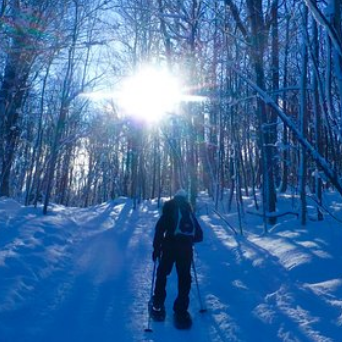 Looking for a way to stay in shape this winter? Snowshoeing is an excellent low-impact aerobic exercise that can burn 600 calories an hour, and is an excellent way to extend your hiking and running season. You also get to enjoy solitude in areas that might be crowded in summer. Snowshoeing is budget-friendly since it does not require expensive lift tickets or fancy gear. It’s also a great social activity that all ages and ability levels can enjoy together. If you can walk, you can snowshoe. As long as the snow depth is 6 or more inches, you’re good to go. If you’re just getting into snowshoeing, renting gear is a great way to get started. The rental shop will set you up with snowshoes suitable to your weight and the conditions where you’ll be snowshoeing. Make sure you check the maximum recommended load for your snowshoes (your weight plus the weight of your pack filled with gear should not exceed the recommended load) and take into consideration the type of snow you’ll be traveling on (freshly fallen powder requires snowshoes with a larger surface area to keep you floating on top of the snow). You may choose not to use poles, or only one pole when snowshoeing. It’s all personal preference. Poles help to maintain your balance while snowshoeing, especially on inclines and declines. They also provide support to help distribute your weight, which can protect your joints and muscles from injury. A good rental shop will help you to make sure your poles are adjusted correctly. You’ll want to dress layers when snowshoeing. As always when exercising outdoors, dress in layers so you can adjust your clothing to suit your activity level and the weather. Avoid cotton because when it gets wet, it stays wet. Instead, choose synthetics or wool because they wick moisture and retain warmth even when wet. Cross-country ski clothing is designed for aerobic winter activity, and can do double-duty as snowshoe clothing.
Walking on flat or rolling ground is fairly easy. Your stride should be wider than it is for hiking in order to avoid stepping on the insides of your snowshoe frames. Because of that, you may find your hips and groin muscles aching a bit after the first few times you snowshoe. Start slowly and plan for short routes. You can build up your level of adventure once you gain confidence and ability. It’s important to listen to your body and plan your snowshoeing adventure accordingly. As a beginner, there is no better way to begin snowshoeing than just going and doing it. At first, use your snowshoes to explore city parks or trails you are familiar with. As you become more experienced, check out the mountains outside of town, or far off backcountry areas filled with nothing but gorgeous scenery. Whether you snowshoe by yourself or with others who are also interested in maintaining or improving their cardiovascular fitness, always let someone know your route and plan in case of an emergency. Be aware of your surroundings, and come prepared with the appropriate gear and clothing. In no time you will enjoy being out and about amidst Old Man Winter!Comments are closed.
|
RAZER GAITERS
 RSS Feed
RSS Feed
